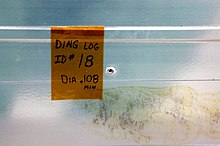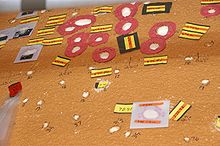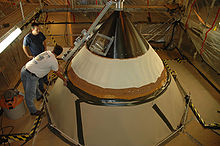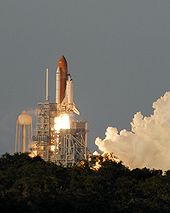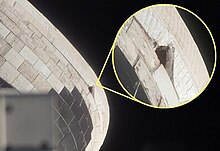STS-117
| Mission emblem | |||
|---|---|---|---|
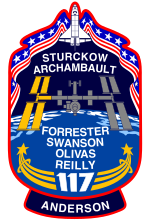
|
|||
| Mission dates | |||
| Mission: | STS-117 | ||
| COSPAR-ID : | 2007-024A | ||
| Crew: | 7th | ||
| Begin: | June 8, 2007, 23:38:04 UTC | ||
| Starting place: | Kennedy Space Center , LC-39A | ||
| Space station: | ISS | ||
| Coupling: | June 10, 2007, 19:36 UTC | ||
| Decoupling: | June 19, 2007, 14:42 UTC | ||
| Duration on the ISS: | 8d 19h 6min | ||
| Number of EVA : | 4th | ||
| Landing: | June 22, 2007, 19:49:38 UTC | ||
| Landing place: | Edwards Air Force Base , Runway 22 | ||
| Flight duration: | 13d 20h 11min 34s (until touchdown) | ||
| Earth orbits: | 219 | ||
| Apogee : | 340 km | ||
| Perigee : | 330 km | ||
| Covered track: | 9.3 million km | ||
| Payload: | S3 / S4 element | ||
| Team photo | |||
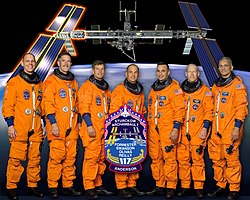 v. l. No. Clayton Anderson, James Reilly, Steven Swanson, Rick Sturckow, Lee Archambault, Patrick Forrester and John Olivas |
|||
| ◄ Before / After ► | |||
|
|||
STS-117 ( english S pace T ransportation S ystem) is a mission designation for the US Space Shuttle Atlantis (OV-104) of NASA . It was the 118th space shuttle mission and the 28th flight of the space shuttle Atlantis. This 21st flight by a US space shuttle to the International Space Station (ISS) transported the S3 / S4 structure to the ISS.
The start had to be postponed from mid-March to early June 2007 due to severe damage to the external tank.
team
- Frederick Sturckow (3rd space flight), commander
- Lee Archambault (1st space flight), pilot
- James Reilly (3rd spaceflight), mission specialist
- John Olivas (1st spaceflight), mission specialist
- Patrick Forrester (2nd spaceflight), mission specialist
- Steven Swanson (1st Spaceflight), Mission Specialist
ISS crew outward flight
ISS expedition 15 / ISS expedition 16
- Clayton Anderson (1st spaceflight), flight engineer
ISS crew return flight
ISS expedition 14 / ISS expedition 15
- Sunita Williams (1st spaceflight), flight engineer
Mission overview
The launch was originally scheduled for March 15, 2007, but had to be postponed due to a severe hailstorm that damaged the shuttle on the tank and some of the heat protection tiles. Due to the necessary repair work, the launch could only take place on June 8, when launch pad 39A was used for the first time in four years .
STS-117 brought the S3 / S4 element to the International Space Station. The component consists of the grid structure S3 and the solar cell carrier S4. The solar panels were extended after installation. In addition, the second wing of the P6 solar module was retracted so that it could later be brought to its final position.
Three space exits were originally planned for the planned work . However, a fourth exit was added during the flight to repair damage to the orbiter.
Preparations
Reactivation of the start ramp 39A
STS-117 was the first mission in over four years from launch pad 39A. This was last used at the start of the STS-107 mission , which ended with the crash of the space shuttle Columbia and the death of the entire crew.
At the end of 2006, work began on preparing the ramp for starting operation again. It was found that there was greater damage than had been assumed. Therefore, for a long time it was not certain whether Pad 39A would be ready in time for STS-117. If this had not been the case, you could have started from Pad 39B. On this ramp, however, the conversions for the test flights of the new Ares I rocket should begin in the following months , so a shuttle launch from this ramp would have led to further delays in the Constellation program . Since ramp 39B had to be ready for a rescue mission of the STS-125 mission, no changes were allowed to be made to the actual launch system. Only minor changes to the launch complex and the construction of three lightning rods were therefore allowed. In mid-January it turned out that ramp 39A would be ready for use in time.
Tests were carried out on Pad 39A at the end of January 2007. Among other things, on January 29, the RSS access platform was moved from the parking to the working position and back again. The next day the pumps for the fuel were put into operation. These checks were necessary because the launch pad had not been used since STS-107 in January 2003.
Prepare the orbiter
After the end of its last mission, the Atlantis was driven into the Orbiter Processing Facility on September 21, 2006 . During the mandatory follow-up inspection of the space shuttle at the beginning of October it was discovered that a micrometeorite had penetrated the radiator of the opened right cargo hold door during the STS-115 flight . The foreign body left a hole measuring 2.7 mm on the entry side and 0.8 mm on the exit side. The radiator was damaged in an area of 2.5 cm around the hole and was repaired a short time later.
The assembly of the solid fuel rockets in the Vehicle Assembly Building (VAB), which began in December 2006 and consisted of four segments that were placed on top of one another and connected to one another, was completed a month later. At the end of December 2006, the external tank also arrived in Florida.
After the assembly of the external tank between the solid fuel booster was completed on January 20, 2007, the Atlantis was rolled to the VAB on February 7. The next day the ferry was connected to an external tank and solid fuel rocket.
On February 15, the space shuttle was driven to Pad 39A. This so-called rollout had to be postponed by a day because a sensor in one of the solid fuel rockets had delivered unusual values during tests. The measuring probe that monitored the chamber pressure was replaced on the launch pad.
Space shuttle damaged by thunderstorm
On February 26th, an unexpectedly violent thunderstorm with hail hit the Kennedy Space Center (KSC). Parts of the shuttle standing on the ramp were damaged. First inspections on the outside tank alone revealed around 7,000 damage to the soft insulation due to the hailstones, some of which were the size of a golf ball, of which ten percent were classified as in need of repair. At least 26 heat protection tiles in the area of the left wing of the Atlantis were also affected. This was the largest hail damage in the history of shuttle flights. According to NASA, the previous record was held by a hailstorm in May 1999, which forced the STS-96 mission to be postponed for three weeks . At that time, the external tank bore over 600 "bumps".
As planned, those responsible for the shuttle program came together at KSC on February 27 for the traditional FRR readiness acceptance inspection. Actually, the airworthiness of all systems should be certified during the flight readiness review. Instead, Wayne Hale , the director of the shuttle program, announced that the Atlantis had to be transported back to the VAB for repair work and further investigations because of the hail damage. An exact inspection is only possible there. In particular, the damage to the orange tank should be repaired. The planned start date, March 15, was canceled, but a new date was not given.
Six days after the hailstorm, the seven-hour transport back to the assembly hall took place on March 4th. It was the 17th so-called rollback of the shuttle program. The last one happened two years earlier when the space shuttle Discovery received a new outer tank for the STS-114 mission in May 2005 .
Repair of the hail damage
Five days after the ferry arrived in the assembly hall, NASA announced that the external tank could be repaired on site. A final assessment of the exact extent of the hail damage to the external tank cannot yet be given, but small repairs have already started. It was feared that in the event of irreparable damage, the tank would even have to be replaced. This would have required dismantling of the orbiter and solid rocket from the tank and a longer waiting time. NASA further stated that the inspection of the solid rocket rocket had already ended and that 28 of the Atlantis heat shields had been damaged. Much of it has already been repaired.
On March 15, Wayne Hale, director of the shuttle program, gave the go-ahead to begin repairs on the outer tank (ET). The preparatory work lasted almost two weeks. First, platforms had to be set up in the VAB in order to be able to examine the entire ET for damage. A special paste was applied to the tip, where most of the hail damage was found, to make even the smallest cracks visible. At the same time, repair techniques were developed in the tank manufacturer's works , because due to the extensive finds at the ET tip, a conventional process (filling and smoothing) was not sufficient there.
After a meeting of those responsible for NASA, the further course of action was set out at a telephone press conference on March 21st. Although the repair of the tank was progressing, it was not expected to start until mid-May at the earliest. While most of the hail damage in the lower and middle area of the outer tank did not need to be repaired or it could be repaired by filling, the damage at the top was serious. Around 1,600 bumps were located there alone - in a very small space and many merging into one another. This section had to be completely removed and applied by hand with spray foam. Because this part of the tank is exposed to the greatest aerodynamic loads during take-off, a few more tests were carried out.
Expansion of the main engines
NASA announced on April 10th that all test results were available and that it had been unanimously decided not to replace the outer tank. Nevertheless, the exchange option remains open if the repaired tank is later classified as "not airworthy". The Atlantis launch will not be possible before June 8th to give the technicians enough time to repair the damage caused by the hail, said Shuttle manager Wayne Hale after a meeting on how to proceed.
On April 30th, the expansion of the three main engines began in the VAB . Possible contamination in the fuel lines was suspected because silicone residue was discovered during maintenance work on the sister ferry Discovery. For several years now, silicone has been used to make impressions of the fuel lines in order to find cracks in the fuel supply. The technicians had waited until the standard repair work in the lower area of the external tank had been completed and the access scaffolding had been dismantled - some of them were very close to the tank. If the engines had been removed in parallel with the work on the tank, there would have been the risk of damaging it again through contact with the platforms, because the entire shuttle sways a little when the heavy engines are removed.
After a week, all engines were reinstalled in the orbiter. While one unit was in perfect condition, a three-millimeter piece of silicone was found in the port engine (SSME-2). A small foreign particle was also detected in engine # 1. Due to a previously scheduled change of a turbo pump, SSME-2 was transferred to the engine maintenance hangar - the other two units remained in the VAB.
Early crew change
Due to the several months postponement of the STS-117 mission, NASA announced at the end of April 2007 that it would bring forward the exchange of American flight engineers on the space station, which was not planned for the next shuttle flight. The astronaut Clayton Anderson , planned for a start with STS-118 , was assigned to the Atlantis crew to replace his colleague Sunita Williams , who has been working on the ISS since December 2006 . As a result of the small change in crew, it was possible to avoid delays in the scheduling of the ISS crews.
Second trip to the launch pad
On May 11, NASA officials met at KSC to discuss whether the shuttle was ready to be driven to the ramp for the second time. It was then explained that all repair work had been completed and assessed and that the Atlantis would leave the assembly hall in five days. The person responsible for the tank, John Chapman, pointed out that the ET would look speckled due to the repaired areas, but the unusual appearance would not affect its flight behavior.
The launch structure was brought back to launch pad 39A on May 15, one day earlier than originally planned. After a journey of 6 hours and 45 minutes, the launch platform was placed on the platforms of the launch ramp. Then the payload, the S3 / S4 segment, was reloaded into the shuttle's loading bay.
Final preparations for launch
The follow-up meeting took place at KSC at the end of May three months after the first readiness for flight inspection. The top management of the shuttle program spent a day and a half discussing the space shuttle's systems and on May 31st certified their operational suitability. The efforts in repairing the external tank were particularly praised. June 8th was confirmed as the start date, which NASA had previously given as a provisional date.
Coming from Houston, the crew in T-38 jets arrived at KSC on June 4th . Commander Rick Sturckow stated that there was a "small setback" when he alluded to the weather-related postponement of the flight. The entire crew appreciated the work of the technicians and engineers who repaired the external tank. The astronauts flew over the ramp a few minutes ago and the tank looks good.
Mission history
begin
The countdown for STS-117 started on June 6th, 2007 and went smoothly from a technical point of view. In return, the weather demanded more attention, because NASA meteorologists predicted possible thunderstorms for the start day.
Eleven hours after the RSS working platform (Rotating Service Structure) was moved into its parking position on June 8, the three-hour filling of the external tank began at around 14:00 UTC. The flight control had previously obtained the latest weather reports, which forecast an 80% probability of good weather for the start period, and gave the green light. The large rain areas north of KSC would pass Cape Canaveral.
The seven-man crew was woken up at the beginning of the refueling and arrived at the launch pad six hours later. After the astronauts boarded, the orbiter's hatch was closed at 21:49 UTC.
About an hour before take-off, the weather at the two TAL landing sites (Transatlantic Abort Landing) had deteriorated so much that they had to report their "closure": Istres in France, which has only been used by NASA as an alternative site for two years, was not available due to fog and it was raining in Zaragoza, Spain . At least one landing site had to be flown to in an emergency, otherwise the countdown should have been canceled. 40 minutes before the start, the fog in Istres had cleared and the military base was operational again.
The Atlantis took off punctually at 23:38:04 UTC. After about two minutes, the two boosters were thrown off. The tank was dropped six minutes later after the three main engines had previously been switched off. Shuttle Program Director Wayne Hale said he was very pleased after doing the first review of the pictures and films of the outer tank. Despite the thousands of repair points, hardly any insulation foam came off during the start, according to Hale.
For the first time, all three main engines (SSMEs) were equipped with an auxiliary computer that was developed by the Marshall Space Flight Center to increase safety. The AHMS (Advanced Health Management System) monitors the high-performance turbo pumps in the engines, which weigh around 500 kg and operate at speeds between 23,000 / min and 34,000 / min. The AHMS uses accelerometers on the pumps to evaluate how strongly they vibrate twenty times a second. If the tolerances are exceeded, the engine can be switched off by the AHMS. Only one SSME was this time equipped with an active control computer - could intervene in an emergency -, the two other motors were only monitored by their AHMS devices.
About an hour and a half after take-off, the cargo bay doors were opened so that the radiators could unfold and the RMS could be checked. A detached heat protection mat was discovered on one of the two OMS (Orbital Maneuvering System) engine pods.
After the wake-up call , the team began examining the heat shield on June 9th. For this purpose, the OBSS extension was attached to the RMS. The two wings and the orbital nose were inspected. A preliminary analysis showed no damage to the heat protection tiles in these areas.
Working on the ISS
The coupling took place on June 10th. At 19:36 UTC, the Atlantis docked at the space station over southeast Australia. The Atlantis had previously performed a 360 ° turn to give the ISS crew the opportunity to photograph the heat shield.
On the same day at around 21:20 UTC, the S3 / S4 segment was hoisted out of the payload bay and passed on to the station arm. In addition, in preparation for the first EVA, the spacesuits were brought from the shuttle to the Quest station airlock , where Reilly and Olivas spent the night. During this so-called campout, they breathed pure oxygen under lower pressure in the airlock. Another important event was the replacement of the Soyusseat in the Soyuz TMA-10 crew capsule. After that, Clayton Anderson was officially a member of ISS Expedition 15 and Sunita Williams was a member of STS-117.
The fourth day of the flight (June 11th) was used to install the new station element. For this, the two shuttle astronauts Olivas and Reilly disembarked into space at 20:02 UTC for the first EVA of this mission. The start of this EVA was delayed by a good hour because the gyroscopes were "saturated" and had to be restarted. Therefore the attitude control of the ISS was handed over to the Atlantis. Then the exit began, in which the two astronauts connected power and data cables between the ISS and the new module, which had previously been brought to its final position with the Canadarm2. In addition, they prepared the SARJ sun tracking mechanism (Solar Alpha Rotary Joint) located in the S3 to rotate the solar panels so that the solar cells are precisely aligned with the sun and can deliver as much electricity as possible. The radiator of the S4 module was also extended. The duo was able to end its mission after 6 hours and 15 minutes.
In the course of June 11, after intensive deliberations, the flight control decided to extend the mission by two days and to integrate a fourth space exit into the flight plan. During this EVA, the insulation mat on the port OMS nacelle of the orbiter, which was damaged shortly after take-off, was to be repaired.
June 12th brought a significant change to the station exterior with the deployment of the S4 solar panels. First, the front wing was extended halfway and, after a while, completely extended before it was turned into the working position. The same procedure was then carried out for the rear panel. The unfolding was done in stages so that the wings could warm up in the sun. This prevented the individual slats from sticking together. This problem occurred when rolling out the first solar panel during STS-97 when the panels were unfolded in one go. The surfaces of the P6 collector unfolded jerkily, which caused wave-like movements along the mast. As a result, the solar cells that were still in the transport canister hit the walls.
Flight day 6 (June 13) began before the astronauts were awakened with an attempt by the control center to partially retract the remaining wing of the P6 element. This was later continued by EVA team Patrick Forrester and Steve Swanson as part of the second exit, which lasted seven hours. Almost half of the wing could be retracted. Then the astronauts unlocked the transport locks of the SARJ tracking wheel on the S3 / S4 element and activated the drive. All of the retaining bolts were supposed to be loosened, but when the two tried to set up a drive coupling, they found that another coupling was reacting because they were incorrectly wired. NASA decided to analyze the problem and loosen the retaining bolts during another exit.
Because only 13 of the 31 slats of the P6 module could be folded up, another attempt was made on the seventh day of the mission, June 14th. The ground station gave the command to roll in for three and a half hours, but the success was low. The wing was still halfway out. So it was decided to address the panel problem during the third exit the following day.
In addition, the residents of the ISS had to struggle with computer problems: In the Russian part of the ISS, while the S4 solar panels were being deployed, three computers that were responsible for monitoring the station's situation, among other things, failed at the same time. According to NASA, in the worst case scenario, the crew would have had to leave the station if the problem were not resolved. The attitude control was handed over to the Atlantis. After several hours, one of the three computers could be started again.
Then an attempt was made to start the other computers as well. A number of fire alarms were produced, which woke the crews an hour earlier than planned. Little by little it was possible to start all computers again. Immediately afterwards, a course correction was made with the engines of the Zarya module. After a few minutes, all computers crashed again. During this time, the Atlantis carried out the course corrections. However, since the ferry's fuel reserves were limited, the computers had to be stable again before undocking. NASA instructed the space travelers to save energy in order to achieve an additional docking day for the Atlantis and to give the computer experts more time. One of the reasons it was assumed was that the failure was caused by electromagnetic interference from the newly installed S3 / S4 element.
After the wake-up call at 12:40 UTC on June 15 (eighth day of flight), the third exit was prepared. This began at 17:24 UTC when Jim Reilly and Danny Olivas left the Quest airlock. The first item on the program was the repair of the heat protection mat on the OMS gondola. Olivas was attached to the shuttle's robot arm and brought to the target area. With his hand he pushed the mat back into place and then clamped it with misappropriated "surgical instruments" from the on-board pharmacy. Meanwhile, Jim Reilly installed a new hydrogen valve on the Destiny module . Then both went to the half-extended P6 wing to finally fold it up. Since the run-in took longer than planned, NASA extended the EVA, which was set at six and a half hours, by one hour. Gradually P6 could be retracted. At 1:22 UTC the EVA ended after 7 hours and 58 minutes.
Success was also recorded in the Russian part of the ISS: After the astronauts had redirected the power supply in the space station, the computers could be started again, although they were not yet running perfectly. In addition, the data obtained by the computer were transmitted to the Russian control center for evaluation.
Flight day 9 was used to load cargo from Atlantis into the ISS and rubbish in the opposite direction. Preparations were also made for the fourth exit the next day. In addition, Sunita Williams broke the long-term flight record for women that Shannon Lucid set on the Russian Mir space station in 1996 . The old record was 188 days and 4 hours. NASA announced that the computers in the Russian part of the station were fully operational again, but that they would be closely monitored.
After the wake-up call at 11:38 UTC, preparations for the fourth and final exit began on June 17 (10th day of flight). This started at 16:25 UTC. During the exit, Patrick Forrester and Steven Swanson loosened the last bolts that had prevented the S3 / S4 segment from turning. A camera was also installed there. Since the duo finished the tasks very quickly, they were able to carry out a few more tasks. These were the laying of an Ethernet cable to Unity, the dismantling of a GPS antenna and the installation of part of the rubble shield on the Destiny laboratory module. The exit ended after 6 hours and 29 minutes at 22:54 UTC.
Flight day 11 was free for the crew, in addition to reloading freight. The crews were also preparing to undock the Atlantis. The S3 / S4 segment was also moved for the first time with the SARJ and aligned with the sun. Additional tests were carried out by NASA to check the station computers. Among other things, the attitude control was passed back from the Atlantis to the ISS computers. This was necessary so that the Atlantis could undock. At 22:51 UTC, the bulkheads between the Atlantis and the ISS were closed, marking both the end of the joint work and the end of Sunita Williams' 190-day stay on the station.
return
On the twelfth day of the mission (June 19), the Atlantis disconnected from the ISS at 14:42 UTC after eight days and 19 hours of joint flight. The station was then circled once at a distance of between 180 m and 200 m in order to obtain video and photo recordings of the ISS in its current configuration. Several large objects were observed moving away from the ISS. The shuttle crew also observed other objects in the course of the day. Presumably it is ice. In the further course of the day the last inspection of the heat shield was carried out with the OBSS and preparations were made for landing.
After the wake-up call, everything that was no longer needed was stowed away on June 20 (13th day of the flight). Among other things, the Ku-band antenna was retracted. In addition, all systems important for the landing were checked and interviews were given to US television stations.
On the 14th day of the flight (June 21), the crew began preparations for landing. The flight control had decided to initially only use the two landing options at KSC on this day. However, the weather conditions did not look very good for the landing. An extensive band of clouds with showers and thunderstorms moved over the KSC, which is why both landing options there were canceled just under two hours before the respective landing. The crew then began preparing for another day in orbit.
The 15th day of flight (June 22nd) began with preparations for a landing. Since the weather conditions for the KSC did not look better than the day before, a landing at Edwards Air Force Base (EAFB) was favored. There were two landing options at KSC and three at EAFB. Because of the bad weather, both landing options at KSC had to be canceled. However, the crew were instructed to drink large amounts of fluids. This served the readjustment to the earth's gravity and on that day suggested a landing in California.
At 17:50 UTC it was announced that they would use the first option on the EAFB. This was confirmed at 18:19 UTC. The deorbit burn started at 18:43 UTC and lasted about 3 minutes. The landing at Edwards Air Force Base took place at 19:49 UTC.
After landing, the orbiter was cooled down. The team then left it and ran around the shuttle. Only Sunita Williams, who had landed in space after 194 days and whose muscles were very weak, was placed under medical supervision immediately after the hatches were opened.
Transfer to Florida
Several hours after landing, the Atlantis was brought to the lifting station. There it was prepared for transport on the modified Boeing 747 , the Shuttle Carrier Aircraft . Among other things, a rear fairing was installed over the engines, which reduces air resistance.
After the return transport on the Boeing 747 to Florida had to be postponed several times due to bad weather, the team started on July 1 from Edwards Air Force Base. After two hours, the Boeing with the Atlantis landed at the regional airport of Amarillo in Texas. There was refueling, and after a two-hour stay, the return journey started again. The 747 then flew to Offutt Air Force Base near Omaha, where it stayed overnight. The next day the 747 took off from Offutt for the US Army Base Fort Campbell in Kentucky. There the 747 stayed overnight with the Atlantis due to the weather situation at the KSC. On July 3, the start of the transport was initially postponed due to the weather at KSC. However, the sky cleared over the KSC so that the flight could continue. Two hours later the Boeing 747 landed with the Atlantis on the Shuttle Landing Facility of the KSC. Then the 747 drove to the lifting station, where the Atlantis was lifted by the Boeing.
After being lifted off the Boeing 747, the Atlantis was driven into the Orbiter Processing Facility. There she was prepared for her next mission ( STS-122 ).
See also
Web links
- NASA: Official Mission Site (English)
- NASA: Mission Overview (English)
- NASA: Mission Photo Gallery
- Video summary with comments of the crew (English)
- Space Science Journal: Mission STS-117
Individual evidence
- ↑ NASASpaceflight.com: NASA may require 'Ares I' pad for STS-117 , January 13, 2006 (English)
- ↑ NASASpaceflight.com: Atlantis on schedule - shuttle summit progressing well , January 18, 2006 (English)
- ↑ NASA: Space Shuttle Processing Status Report , October 6, 2006 (English)
- ↑ NASASpaceflight.com: Atlantis' ET arrives ahead of STS-117 , December 30, 2006 (English)
- ↑ NASA: NASA's Shuttle Atlantis Rolls to Vehicle Assembly Building , February 7, 2007 (English)
- ↑ NASA: Shuttle Atlantis Moves to Pad, Crew Ready for Countdown Test , February 15, 2007 (English)
- ↑ NASA: Hail Damage Forces Shuttle Atlantis Off Launch Pad , February 27, 2007 (English)
- ↑ Florida Today: Atlantis rollback complete. March 5, 2007
- ^ Todd Halvorson: NASA starts repair work on damaged tank . ( Memento from September 30, 2007 in the Internet Archive )
- ↑ Michael Cabbage: Atlantis' fixes push liftoff to May . ( Memento from June 20, 2007 in the Internet Archive )
- ↑ NASA: NASA Targets June Launch for Space Shuttle Atlantis , April 10, 2007 (English)
- ↑ NASA: NASA to Rotate Station Astronauts on Next Shuttle Mission , April 26, 2007 (English)
- ↑ Florida Today: Shuttle tank flight-ready, NASA says. May 12, 2007
- ↑ NASA: NASA Gives "Go" for Space Shuttle Launch on June 8 , May 31, 2007 (English)
- ^ John Kelly: Atlantis crew arrives at KSC . ( Memento from September 30, 2007 in the Internet Archive )
- ↑ NASA: NASA's Shuttle Atlantis Begins Mission to the Space Station , June 8, 2007 (English)
- ↑ NASA: NASA Shuttle Engine Upgrades Improve Safety and Reliability , June 5, 2007 (English)
- ↑ astronews.com: Atlantis mission extended by two days , June 12, 2007
- ↑ NASA: STS-117 MCC Status Report # 15 , June 15, 2007 (English)
- ↑ NASA's Landing Blog (English)
- ↑ SpaceflightNow.com: Atlantis arrives back home after cross-country trip , July 3, 2007 (English)

